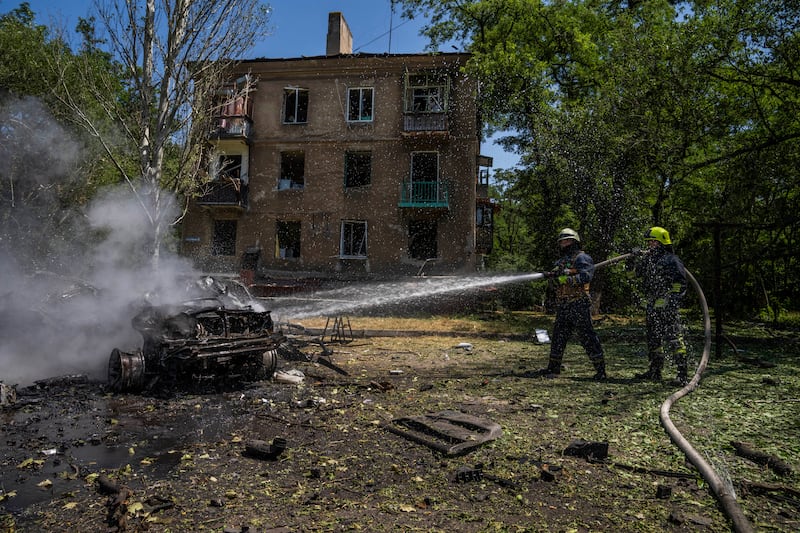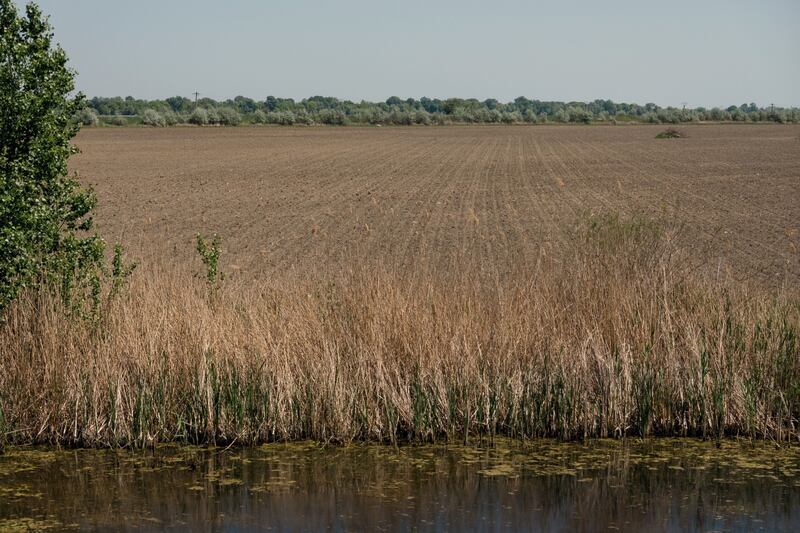Russian forces are managing to “raise true hell” in Ukraine’s eastern industrial heartland despite reports of them taking an operational pause, a regional governor has said.
The Ukrainian government has urged people in Russian-occupied areas in the south to evacuate “by all possible means”, while deadly Russian shelling was reported in Ukraine’s east and south.
The governor of Luhansk, Serhyi Haidai, said Russia launched more than 20 artillery, mortar and rocket strikes in the province overnight and its forces are pressing towards the border with neighbouring Donetsk.
“We are trying to contain the Russians’ armed formations along the entire front line,” Mr Haidai wrote on Telegram.
Russian forces expected to mount new offensive to strengthen hand at talks
Efforts to rearm Europe stumble as Trump ‘kicks over the chessboard’ of the Ukraine war
US ‘demanding all of Ukraine’s natural resources for years’
European leaders united in opposition to lifting sanctions on Russia as condition of ceasefire in Ukraine
“So far, there has been no operational pause announced by the enemy. He is still attacking and shelling our lands with the same intensity as before.”
Last week, Russia captured the last big stronghold of Ukrainian resistance in Luhansk, the city of Lysychansk. Analysts predicted Moscow’s troops would take time to rearm and regroup.
Ukraine’s deputy prime minister Iryna Vereshchuk appealed to residents of Russian-held territories in the south to evacuate so the occupying forces cannot use them as human shields in the event of a Ukrainian counter-offensive.
[ Ukraine’s digital defences hold out in cyber war with Russian hackersOpens in new window ]
Speaking at a news conference late on Friday, Ms Vereshchuk said a civilian evacuation effort was under way for parts of the Kherson and Zaporizhzhia regions. She declined to give details, citing safety considerations.
It was not clear how civilians were expected to safely leave Russian-controlled areas while missile strikes and artillery shelling continue in surrounding areas, or whether they would be allowed to depart or even hear the government’s appeal.
Meanwhile, the war’s death toll continued to rise.
Five people were killed and eight more wounded in Russian shelling on Friday of Siversk and Semyhirya in Donetsk province, its governor Pavlo Kyrylenko said on Saturday.
In the city of Sloviansk, likely to be the next target of Russia’s offensive, rescuers said they pulled a 40-year-old man from the rubble of a building destroyed by shelling on Saturday morning. Mr Kyrylenko said multiple people were trapped in the debris.
Russian missiles killed two people and injured three others on Saturday morning in the southern city of Kryvyi Rih, say regional authorities.
“They deliberately targeted residential areas,” Valentyn Reznichenko, the governor of the eastern Dnipropetrovsk region, said.
Kryvyi Rih’s mayor Oleksandr Vilkul said that cluster munitions had been used, and he urged residents not to approach unfamiliar objects in the streets.
Seven people were injured in a Russian rocket strike on Ukraine’s second-largest city, Kharkiv, on Saturday morning and three of them were taken to hospital, including a child, regional governor Oleh Syniehubov said.
In the southern city of Mykolayiv, mayor Oleksandr Senkevych said a Russian missile attack was under way. He did not mention casualties.
The British ministry of defence reported on Saturday that Russian forces in Ukraine are now being armed with “obsolete or inappropriate equipment”, including MT-LB armoured vehicles taken out of long-term storage.
The MT-LB entered service in the Soviet military in the 1950s and does not provide the same protection as modern armoured vehicles.
“While MT-LBS have previously been in service in support roles on both sides, Russia long considered them unsuitable for most frontline infantry transport roles,” the UK ministry of defence said on Twitter.
The Russians also have brought Cold War-era tanks out of storage.

Meanwhile, Ukraine is restoring and expanding some of its long-decommissioned river ports on the Danube to facilitate the exportation of grain due to Russia’s Black Sea blockade.
Before the war, Ukrainian river ports on the Danube were seldom used, with some of them in complete disrepair. But following Russia’s invasion of Ukraine and its control of exit routes to the Black Sea, Kyiv is resuscitating its old river harbours to avoid the sea blockade and accelerate the exportation of the country’s wheat.
“Take the example of the Reni river port,’’ Alla Stoyanova, the head of the department of agricultural policy of Odesa region, said. The port was among the most important of the Danube region during the Soviet Union and a passageway to Romania. “It wasn’t used at all recently. So now we are working to expand it, alongside other river ports, to increase capacity. As we speak, 160 ships are awaiting in the Black Sea to enter the Sulina canal, but they can’t because the capacity of that canal is only five to six ships a day.”
At the beginning of the Russian invasion, silos and ports across Odesa were brimming with more than 25 million tonnes of grain. Today, 5 million of these have been exported via alternative street, rail and river routes.
“In March we managed to export 200,000 tonnes”, said Ms Stoyanova. “In April 1.6 million; in May 1.7 million tonnes; and in June 2.5 million. But this capacity is still not enough, because normally with our six ports in the Odesa region we used to export 5-6 million tonnes of grain every month.’’
Before the war, about five or six ships left the port of Odesa carrying a total of 100,000 tonnes of grain, with one single vessel having the capacity to carry up to 50,000 tonnes.
“One truck can carry only 25 tonnes and a train carriage 60 tonnes” says Ms Stoyanova. “In order to load the equivalent of one grain-carrier ship, we would need 2,000 trucks. All those long queues of trucks and trains you can see at the border is because the neighbouring countries aren’t able logistically to manage this much grain from us.”
Insofar as Kyiv is planning to expand its river ports with at least two new silos and special parking spaces for trucks to load the grain carriers faster, the fact remains these are only emergency measures to maintain the shipment of grain. Ukrainian officials are aware that opening the Black Sea route is the only way to mitigate global hunger.

“The truth is that there’s no alternative to seaports”, said Ms Stoyanova. “We must immediately unblock them. The world can find a way to make Russia agree to this. We don’t only want Russia to promise something, but we want it to agree [to unblock our seaports] within the decision of the UN general assembly. If Russia agrees to that, they won’t be able to take a step back [from the agreement].”
“If, unfortunately, we lose soldiers every day that bravely defend our country, there are other stats too, like every 48 seconds one person in the world dies of starvation”, she says.
The number of people going hungry in the world has risen by 150 million since the start of the Covid pandemic, said the UN warning that the food crisis sparked by Russia’s invasion of Ukraine risks pushing the worst-hit countries into widespread famine.
On Thursday, while Sergei Lavrov, the foreign minister of Russia, said Moscow was ready to negotiate with Ukraine about grain, a series of Russian missiles destroyed two harvesters containing 35 tonnes of grain in the Odesa region, says local authorities.
In the meantime, Ukrainian farmers in occupied territories have had no choice but to sell their harvests to the Russians.
[ Martin’s Ukraine visit is something of a double-edged swordOpens in new window ]
Two Ukrainian farmers in the occupied Kherson region said they sold their grain to Russian buyers last month at discounted prices. “My grain was sold almost 20% cheaper than usual. But it’s better than nothing,” said one farmer, who asked for anonymity for fear of reprisals from local authorities.
“I did not have enough space to store grain, so selling was the only option,” the farmer said. The second farmer said he was approached by an agricultural firm based in Crimea, which asked him to sign documents to prove the grain was bought “legally”.
He said he sold his grain for roughly €98 ($100) a tonne, which was “barely above” the cost of production.
On Tuesday, the Moscow-installed head of the south-eastern Zaporizhzhia region said the Russian news agency Tass that Ukrainian farmers in occupied territories received about €196 ($200) a tonne for grain.
A sprawling transport network appears to have also emerged to send the grain from the Kherson region to ports in southern Crimea, usually the first stop for Ukrainian grain.
“We receive a lot of requests for grain transport from Kherson to Crimean ports,” said Anna, a manager at a logistics firm based in the border region of Rostov. “People are willing to pay us very good money to pick up the grain and move it to Crimea, a journey which isn’t always safe.”
Heavy fighting continues in the region, as Ukraine, boosted by newly received western weapons, aims to stage a counterattack to reclaim territory.
Anna said her company has been sending three to five trucks every day to pick up grain from Kherson and ship it to the Crimean ports of Sevastopol and Kerch.
On Thursday Nasa said Russian forces now occupied about 22 per cent of Ukraine’s farmland, with Kyiv accusing Russia of stealing more than 600,000 tonnes of grain from occupied Ukrainian territories to sell on international markets.
The same day, Ukraine summoned the Turkish ambassador, saying Turkey had allowed a Russian-flagged ship carrying what it said was thousands of tonnes of stolen Ukrainian grain to leave the port of Karasu.
Turkish customs officials seized the vessel at Ukraine’s request on Tuesday, after Kyiv said the cargo was illegally transporting 7,000 tonnes of grain out of Russian-occupied Berdiansk, a port in the southeast of Ukraine.
There has been growing evidence that some of the Ukrainian grain that arrives at those ports is then shipped abroad, mainly to ports in Syria and Turkey. — Guardian














